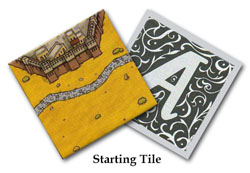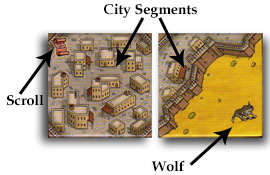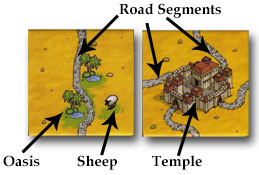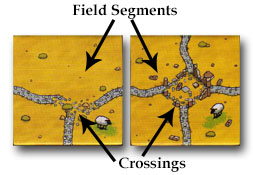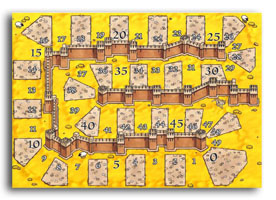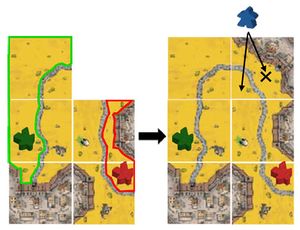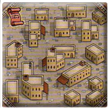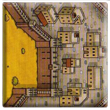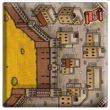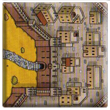The Ark of the Covenant Base Game
Main Page > The Ark of the Covenant > The Ark of the Covenant Base Game
General Info and Comments
The Ark of the Covenant was originally released in 2003 [1]
Based on the 2001 Game of the Year: Carcassonne [2]
A Clever Tile-Laying Game for 2-5 Players Ages 8 and up, by Klaus-Jürgen Wrede.[3]
"Joshua has led the children of Israel into the Promised Land and you have been given the unique responsibility to help develop the area by building roads, cities, temples and raising sheep. Deploy a Prophet into the cities to preach repentance. Take on the sacred duty of moving The Ark of the Covenant around to different areas of the Land."
![]() Question: Can anyone state whether the game is generic Christian, or has certain specific features that are specialised to certain segments of Christianity?
Question: Can anyone state whether the game is generic Christian, or has certain specific features that are specialised to certain segments of Christianity?
Answer: The game teaches no doctrine – it is based on an Old Testament theme, and has common Old Testament references like prophets and temples, but that’s the extent of the doctrine. It should be non-offensive for anyone, regardless of their religious beliefs.
Contents
- 72 Land Tiles (including one starting tile with a different coloured back) which picture city, road and field segments and temples
- 40 Followers in 5 colours - one of each player's followers is used as the player's scoring marker
- 5 Prophets – Extra-large followers [4], one of each colour
- 1 Ark of the Covenant [5]
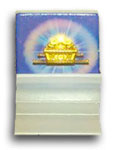 First Edition (2003) or
First Edition (2003) or 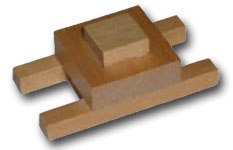 Second Edition (2005)
Second Edition (2005)
- 1 Scoring Track, used to track the player's scores
- Rule Booklet
Overview
Players take turns placing land tiles on the table. [6] As they do so, the roads, cities, fields and temples emerge and expand. On these tiles, the players can place their followers to earn points. Players can also score points by moving The Ark of the Covenant throughout the land past their followers. After the final scoring round, the player with the most points is the winner. [7]
Preparation
Place the starting tile face up in the middle of the table. Shuffle the remaining tiles face down and stack them in several face-down stacks so that all players have easy access to them. Place the scoring track off to the side, leaving room to place land tiles in the middle of the table. [8]
Each player takes the 8 followers and 1 Prophet in his colour and places one follower as his scoring marker on the starting space of the scoring track. Each player places his remaining pieces before him on the table as his supply. The player who last read a portion of the Bible will be the starting player. [9]
Playing the Game
Players take turns in a clockwise order, beginning with the starting player. On a player's turn, he performs the following actions in the order shown: [10]
1. The player must draw a new land tile and place it on the table.
2. The player now chooses one of the following actions:
- a) Place one of his followers from his supply to the land tile he just placed or the Prophet from his supply to a city portion of that land tile (if applicable)
- or
- b) Instead of placing a follower or Prophet, the player may move The Ark of the Covenant across 1 to 5 tiles on the board.
- or
- c) The player may elect to take no action.
3. If, by placing the land tile, roads, cities or temples are completed, they are now scored.
4. The next player’s turn now begins.
The Fields
Connected field segments are where your followers herd sheep.
Fields are bordered by roads, cities and the edges of the area where the land tiles have been played. [11]
When you place a follower in a field, that follower remains in the field, watching over the flocks, until the end of the game and are never returned to the player's stock.
Game End
At the end of the player's turn in which the last land tile is placed, the game ends. Final scoring then takes place.
Final Scoring
First, for each incomplete temple, the player or players with the majority of followers on the temple tile and on the four surrounding tiles (right, left, up and down) score 3 points. After you score the temples, leave the followers in place as they may still be scored for incomplete roads and cities as well as fields.
Second, all incomplete roads and cities are scored. For each incomplete road and city, the player who has a follower on a road or followers/Prophets in a city, earns one point for each road or city tile. [12] Scrolls in the cities, as well as oases on the roads, are also worth 1 point each.
For incomplete roads and cities which include more than one follower, use the rules for completed roads and cities to determine who scores.
Note: To make scoring easier, after scoring an incomplete road or city, remove the corresponding follower off the board.
Scoring Fields
The followers in the fields are now scored.
- Count how many sheep and wolves are in the field. For each wolf in a field, a sheep is eaten by the wolf and that sheep is not scored. [13]
- The remaining sheep in your field are worth 2 points each.
- If multiple players have followers in a single field area, only the player with the most followers scores.
- If there is a tie for control of a field, then both players receive the points.
![]() Question: Can you score negative points if there are more wolves than sheep in a field?
Question: Can you score negative points if there are more wolves than sheep in a field?
Answer: You cannot go negative.
The player with the most points at the end of the final scoring is the winner!
Tips
- When you place followers in the fields, place them lying down so that all players can easily see which fields they are in. [14]
- Don't underestimate the usefulness of moving The Ark. If you can't score any points by placing a follower or if you have limited followers, go for the easy points by moving The Ark past your followers.
- After your turn has passed, immediately grab a new tile so that you can be looking at where you will play when your turn comes up again. This dramatically speeds up play time.
Tile Distribution
72 tiles:
Footnotes
For Icons explanation and licensing please visit Icons page.
- ↑ The first edition English rules (2003) were developed by Jeremy Young, Matt Molen and Guido Teuber. This development team were joined for the second edition release (2005) by Rick Thornquist and Greg Aleknevicus.
- ↑ Carcassonne by Klaus-Jürgen Wrede is published by Hans im Glück (European edition) and Rio Grande Games (American English edition) Ed: RGG was the English publisher in 2008, when the CAR was produced. Since that time the English version of Carcassonne has also been published by Z-Man Games.
- ↑
 The first edition read: 'A Clever Tile-Laying Game for 2-5 Players aged 10 and above'
The first edition read: 'A Clever Tile-Laying Game for 2-5 Players aged 10 and above'
- ↑ Do not get confused between the Prophet (extra large follower) and a follower. The Prophet can only be deployed in a city, and then only once. After a player has scored with it the Prophet is removed from the game.
- ↑ In the first edition a cardboard ark token and plastic stand was provided. In the second edition, the cardboard Ark was upgraded to a wooden Ark, the picture also being changed for that edition.
- ↑
 The first edition read: 'The players place land tiles turn by turn on to the table.'
The first edition read: 'The players place land tiles turn by turn on to the table.'
- ↑
 The first edition read: 'The player with the most points, after the final scoring round, is the winner.'
The first edition read: 'The player with the most points, after the final scoring round, is the winner.'
- ↑
 The first edition read: 'Place the scoring track near one edge of the table to leave room for the players to place land tiles in the middle of the table.'
The first edition read: 'Place the scoring track near one edge of the table to leave room for the players to place land tiles in the middle of the table.'
- ↑ Due to the market that The Ark of the Covenant was aimed at, this rule is not surprising. Should you find that no player has read the Bible then the players should decide amongst themselves as to which player will start the game. However, why not read a portion of the Bible, so you are ready for your next game?
- ↑
 The sequence in the first edition read:
The sequence in the first edition read:
'1. The player must draw a new land tile and place it on the table.
2. The player may place one of his followers from his supply to the land tile he just placed or the Prophet from his supply to a city portion of that land tile (if applicable).
-OR-
3. Instead of placing a follower or Prophet, the player may move The Ark of the Covenant across 1 to 5 tiles on the board.
4. If, by placing the land tile, roads, cities or temples are completed, they are now scored.
5. The next player’s turn now begins.' - ↑ In the first edition, this paragraph came after the next one.
- ↑ The first edition read: 'For each incomplete road and city, the player who has a follower on a road or in a city, earns one point for each road or city segment.'
- ↑
 The first edition read: 'Count how many sheep and wolves are in the field. Each wolf eats one sheep!'
The first edition read: 'Count how many sheep and wolves are in the field. Each wolf eats one sheep!'
- ↑ Followers deployed in fields are shown in the graphics throughout this guide as lying down. They are not shown as such in the official rules.

